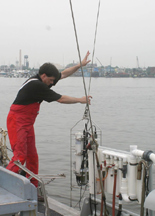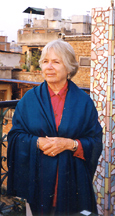|
Dock of the Bay
Courtney Kennedy and Theresa Puckett from Ohio came early.
“London Town had run out of steam,” said Greg Stiverson, who moved from director of the London Town Foundation to the same position with the Historic Annapolis Foundation. “So when the opportunity came around, we took it.” Stiverson is quick to diffuse any idea that his move to Annapolis precipitated the show’s move. “We were already going to give it up when I accepted my position in Annapolis,” he explained. Putting on the show takes a tremendous effort, and Stiverson says the London Town volunteers just got tired. “After a little while, it became work,” he said. A sentiment echoed by the dealers from Ohio. “It’s amazing it even comes together,” said Kennedy, looking around the empty stalls 32 other dealers had barely begun to decorate just a day before the show began. The busiest person at the National Guard Armory the morning before the show officially kicked off was the Antique Show’s producer Robert Armacost. “I’ve got dealers signed up to do the show about a year in advance,” said Armacost. “I do floor plans and advertising, make arrangements for physical setup — walls for the booths, porters to bring merchandise, insurance liability.” That’s all before the first visitor steps through the front door. Then, said Stiverson, “It’s great fun. We bring dealers from the U.S. and England with medium- to high-end antiquities that aren’t found just anywhere.” Specialty dealers bring Oriental rugs, rare prints, furniture, medieval illuminated manuscripts and much more. From pottery to jewelry, the wares cover the spectrum. This year, the show highlights the silver of Annapolis, with symposiums on the history of silversmiths in the area and their effect not just here but in the antiques world. “We see this primarily as an educational opportunity,” said Stiverson. “Visitors can go in, ask questions and learn. And, hopefully, find something to treasure in their homes.” But first, the hardest work must be done. Like a traveling circus, dealers have to put up their booths before showing their work for four days. They take it all back down before heading out to another city. Puckett and Kennedy go back home for a couple of weeks before heading out to Nashville. “In a couple of days, we’ll look a little nicer than we do now,” laughed Puckett of her jeans and sweatshirt. As Stiverson and Armacost know, so will the Armory. — Louis Llovio
Big, Bad Chemicals When you do your laundry, steam clean your rug, fertilize your lawn, change your motor oil and heat your home, you are inadvertently releasing toxic chemicals into Chesapeake Bay. The fragrance in your deodorant, the flame retardant in your sofa cushions, the Scotch Guard on your carpet, any pharmaceuticals you swallow: All of these eventually go down the drain, and at the end of the drain is the Chesapeake.
What do PBTs mean for animals and humans who take their meals from the Chesapeake? Exact answers haven’t yet been pulled from the tangle of threats we pose ourselves, but examples from the past remind us that consequences can be serious. Remember the effects of DDT on populations of eagles and osprey in the 1960s and 1970s, before that chemical was banned from our fields? DDT itself is not a persistent chemical, but it breaks down into a persistent chemical called DDE, which stops birds from forming proper eggshells. The bioaccumulation of DDE caused years of reproductive failure in eagles and ospreys. In human populations, developmental problems such as hyperactivity and lower intelligence, as well as certain cancers, have been linked to exposure to DDT. Baker’s lab of 12 researchers tracks persistent chemicals in the Bay. This is trickier than tracking a specific chemical to a specific pipe outflow. Chemicals are all around us. Running off from asphalt parking lots and agricultural fields, they are combined in complex mixtures. In the Bay, they may recombine to form a really nasty chemical soup. Like a cop on a criminal investigation, Baker uses fingerprinting to identify the bad guys. “Any natural water, including the Chesapeake Bay, contains literally thousands of chemicals. Many are natural — sugars, proteins, pigments produced by algae, for example. Some are man-made — pesticides, components of burning, consumer products. Our approach is to measure the levels of many different chemicals in the water and relate these ‘fingerprints’ to known pollutants,” Baker explained. “For example,” he said, “if we measure the chemical composition of treated effluent from a sewage treatment plant and we find this same composition in a water sample downstream, we can estimate how much influence the sewage treatment plant is having on the Bay’s water quality.”
Imagine steam cleaning your carpet. The water, laced with BDEs, goes down the drain, into the Bay where it settles in sediments, is taken up by plankton and bottom dwellers, who are in turn eaten by fish, mammals, birds and humans in ever increasing amounts. BDEs have already turned up in human breast milk and in birds. In spite of what we know about DDT and other classic chemicals like PCBs, says Baker, regulation of new chemicals is not easy. “For some of the ‘classic’ chemicals, the toxicology is fairly well understood, and we can set rational guidelines, although people still argue, just as they do about cigarette smoke,” he says. In the U.S., new chemicals — like criminal suspects — are innocent until proven guilty. Which means they’ll have a legacy of crime behind them before we go after them. “For ‘new’ chemicals such as BDEs, it will likely be years before enough studies are done to document the health effects of these chemicals. The problem is that once these things are in the environment, it may be difficult and expensive to clean up the system,” says Baker. In contrast, Europeans use the ‘precautionary principle’ to assess risk, requiring that industry and government prove that new products are safe before use. BDEs are already banned in the European Union and in California, where aggressive antipollution laws make the difference. In Maryland, BDEs have made it as far as the Maryland Department of the Environment’s chemical watch list. Baker’s lab works as an advisory body to that agency, whose Fish Tissue Monitoring Program samples recreational and commercial fisheries on a five-year cycle so that every year about one-fifth of the state’s waters are sampled. Fish are analyzed for a variety of chemicals, including metals, mercury, PCBs and the new BDEs. The state uses this data to advise us on what’s safe to eat. But that’s a very imperfect science. Chemists have no trouble measuring very small quantities of chemicals in fish; what’s not easy is determining the consequences for us fish-eaters. — Martha Blume Non-toxic Alternatives Keep the Bay Healthy
Doña Quixote Takes on Big Business Don Quixote took on windmills in La Mancha. In Annapolis, Anne Pearson is taking on Wal-Mart.
Shuman has led similar studies in St. Lawrence County, New York, and Santa Fe, New Mexico. His clout is part of Pearson’s plan to get results. “We’ll use the study to institute legislation that limits big boxes that suck money out of the local economy and damage quality of place,” she says. Pearson wasn’t always taking on windmills. After half a century in Annapolis, she moved her family to the woods near Easton. “I owed it to my children to pass on basic values,” she says. One midnight she was skiing back to the log cabin she shared with her children when, seeing the snow draped over the evergreens, she thanked God for letting her own such a beautiful spot. Then she caught herself. “I suddenly realized,” said Pearson, “that I don’t own this.” Correcting herself, she thanked God for letting her live there. Soon, she returned to Annapolis to create the Alliance for a Sustainable Community. “We work with representatives from all levels of government, citizens and innovators to reduce our impact on the earth,” says Pearson of the organization she began in 1994. Now, though, her focus is on Annapolis and its local merchants. “Locally owned business’ cater to their customer better,” she argues. “They are willing to go the extra mile to make you happy.” What’s more, shopping locally will, in the long run, lead to a cleaner Bay and less pollution. “Annapolis is a walking town,” says Pearson. “If people shopped downtown, they could walk or ride bikes. Most pollution comes from cars. Less cars, less pollution.” Like Quixote, Pearson believes she can take on more than one windmill at a time. Annapolis’ local merchants hope she can. To donate or help with the study: Alliance For Community Education. 410/956-1002 • [email protected]. — Louis Llovio AA County’s 20-Acre Remedy Do you avert your eyes at sprawling construction sites with every tree gone and the earth eroding into ditches and streams? In Southern Anne Arundel County, locals fighting to keep the public land at Franklin Point pristine and free of ballfields have a suggestion for a name to honor a local hero who died unexpectedly this month: Gus Jackson Nature Preserve, after the geologist and activist from Shady Side who worked for environmental and humanitarian causes until dying of malaria New Year’s Day … In Cecil County, the Susquehanna National Wildlife Refuge will be expanding. Neither the feds nor the state are investing much in land preservation, but a resolution just passed by Congress will let the Fish and Wildlife Service buy Garrett Island from private owners … In the Florida Keys, John Cunningham is convinced he’s invented just what people need in this era of anthrax and killer germs: a germicidal mailbox. Cunningham received a patent recently for a device that sterilizes incoming letters by irradiation from a moving ultraviolet light triggered when the mailbox is closed. No word on what it does to grandma’s chocolate chip cookies …
|
© COPYRIGHT 2004 by New Bay Enterprises, Inc. All rights reserved.
Last updated January 15, 2004 @ 12:13am.





 Our Creature Feature comes from the High Plains of America where, thanks to Mad Cow Disease, there may be a comeback by what was once western America’s greatest source of food: bison. Analysts see the bison, or buffalo, becoming more popular if fear of beef persists.
Our Creature Feature comes from the High Plains of America where, thanks to Mad Cow Disease, there may be a comeback by what was once western America’s greatest source of food: bison. Analysts see the bison, or buffalo, becoming more popular if fear of beef persists.